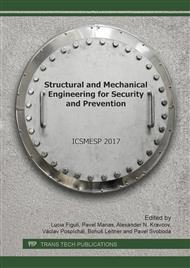[1]
P. Michelberger, Cs. Lábodi, After Information Security – Before a Paradigm Change: A complex Enterprise Security Model, Acta Polytechnica Hungarica 9: (4), 2012, pp.101-116.
Google Scholar
[2]
T. Szádeczky, Information Security Law and Strategy In Hungary, Academic and Applied Research In Public Management Science 14: (4), 2015, pp.281-289.
DOI: 10.32565/aarms.2015.4.2
Google Scholar
[3]
Z Rajnai, B. Puskas, Requirements of the Installation of the Critical Informational Infrastructure and its Management, Interdisciplinary Description of Complex Systems 13: (1) pp.48-56.
DOI: 10.7906/indecs.13.1.7
Google Scholar
[4]
D. Phuoc, A. Kerti, Z. Rajnai, E-Learning Security Risks and Countermeasures, International Journal of Emerging Research and Solutions in Ict 1: (1), 2016, pp.17-25.
DOI: 10.20544/ersict.01.16.p02
Google Scholar
[5]
Szádeczky Tamás, Risk Management of New Technologies, Academic and Applied Research in Military and Public Management Science 15: (3), 2016, pp.279-290.
DOI: 10.32565/aarms.2016.3.8
Google Scholar
[6]
Z. Nyikes, Z. Németh, A. Kerti, The electronic information security aspects of the administration system, 2016 IEEE 11th International Symposium on Applied Computational Intelligence and Informatics (SACI), Timisoara, DOI: 10. 1109/SACI. 2016. 7507395, 2016, pp.327-332.
DOI: 10.1109/saci.2016.7507395
Google Scholar
[7]
S. Répás, I. Dalicsek, Az információbiztonsági kockázatelemzés módszertani kérdései a kritikus infrastruktúra elemeket üzemeltető szervezetek esetében, NKE állam- és közigazgatás-tudományi szakmai folyóirata 4, 2015, pp.22-33.
Google Scholar
[8]
T. Jenei, Comparison of the most frequently used models of risk management, International Journal of Engineering and Management Sciences (IJEMS) Vol. 1. 2016. No. 1., DOI: 10. 21791/IJEMS. 2016. 1. 22., pp.1-11.
Google Scholar
[9]
K. Lazányi, Who do You Trust? - Safety Aspect of Interpersonal Trust among Young Adults with Work Experience In: Szakál Anikó (szerk. ) Proceedings of the11th IEEE International Symposium on Applied Computational Intelligence and Informatics SACI 2016. Budapest: IEEE, pp.349-354.
DOI: 10.1109/saci.2016.7507400
Google Scholar
[10]
Csiszárik - Kocsir Ágnes, Varga János, Crisis - Project - Risk: According to the Opinions of Hungarian SMES', Project Management Development - Practice and Perspectives: Sixth International Scientific Conference on Project Management in the Baltic Countries. 2017. pp.60-70.
DOI: 10.22364/pmdpp.2017
Google Scholar
[11]
Miniszterelnöki Hivatal Informatikai Tárcaközi Bizottság 8. számú ajánlása (MeH ITB 8. ), Informatikai biztonsági módszertani kézikönyv. CRAMM módszertan, 1994, pp.1-145.
Google Scholar
[12]
Zs. Szabó, Options of micro-simulation in the modelling of the pension system and the intelligent IT security system. Computational Intelligence and Informatics (CINTI), 2016 IEEE 17th International Symposium on Óbudai University 17-19. Nov. 2016, Conference book, Electronic ISSN: 2471-9269. INSPEC Accession Number: 16656968. DOI: 10. 1109/CINTI. 2016. 7846421. 2017, pp.295-298.
DOI: 10.1109/cinti.2016.7846421
Google Scholar
[13]
Az állami és önkormányzati szervek elektronikus információs rendszerek biztonságáról szóló 2013. évi L. törvény (Ibtv. ), Magyar közlöny 2013. évi 68. sz., pp.50241-50255.
DOI: 10.36820/mtakik.kozl.2022.mtatorveny
Google Scholar
[14]
41/2015. (VII. 15. ) BM rendelet (BMr. ) az állami és önkormányzati szervek elektronikus információbiztonságáról szóló 2013. évi L. törvényben meghatározott technológiai biztonsági, valamint a biztonságos információs eszközökre, termékekre, továbbá a biztonsági osztályba és biztonsági szintbe sorolásra vonatkozó követelményekről, Magyar közlöny 2015. évi 103. sz., pp.17700-17751.
DOI: 10.32577/mr.2018.5.8
Google Scholar


